Remote office upgrades 2024, part 2: Windows Gaming PC, KVM switch, 192 GB RAM for AI/LLMs
2024 brought a new 49" monitor for efficient work but also gaming experiences. Buying a gaming PC, connecting it to the environment with a KVM switch, and then reconsider the Windows setup for containers, VMs and AI/LLMs was a fun challenge.
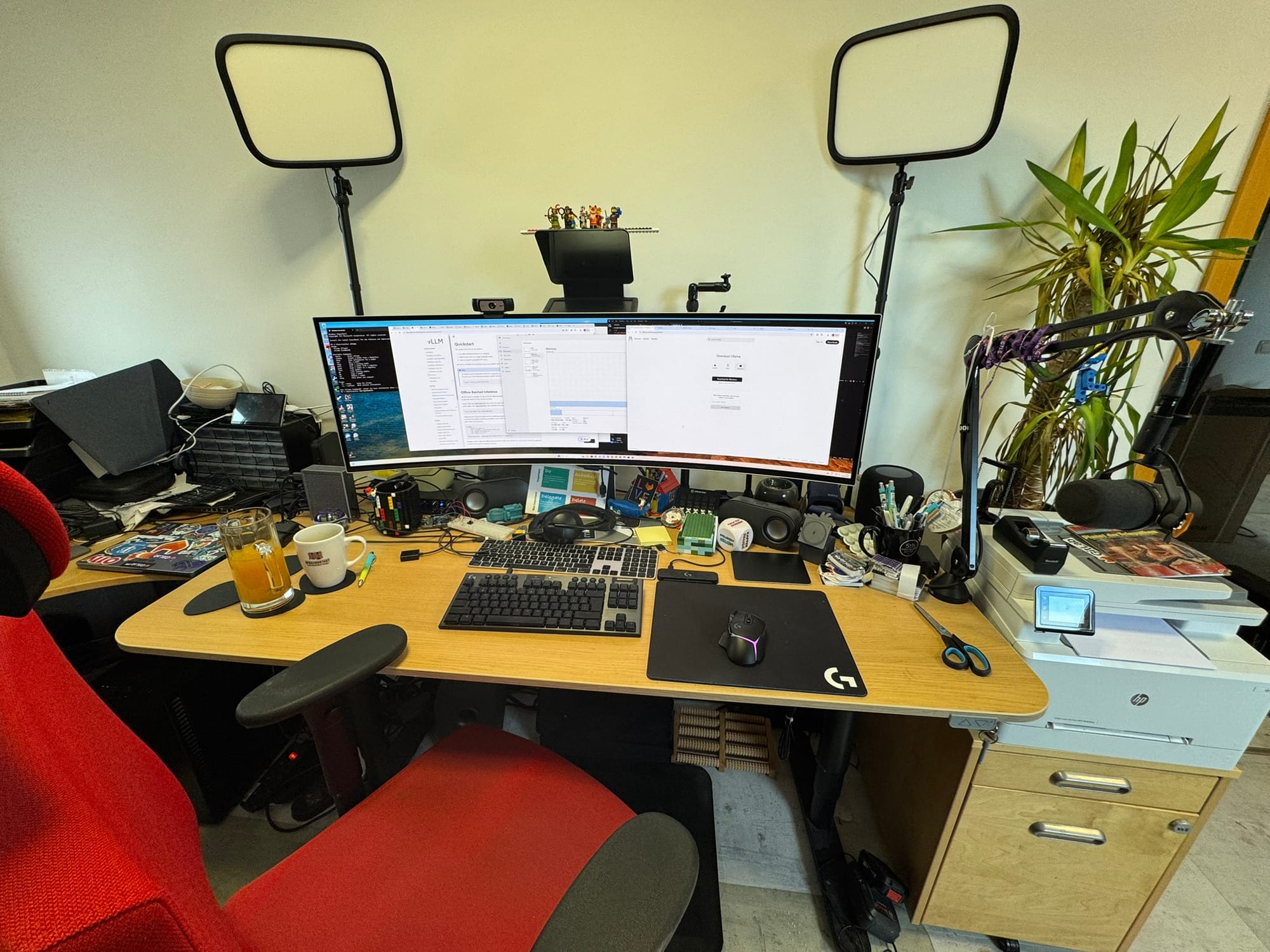
After upgrading my remote office setup in early 2024 with a new 49" monitor and Caldigit Docking station, a discussion about multiple monitor / PC support started in the LinkedIn post comments.
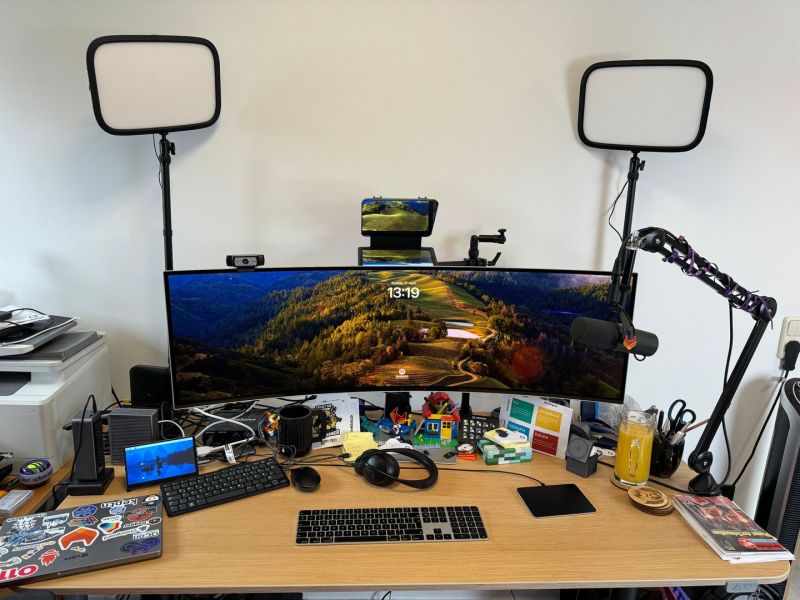
I always had the plan to eventually get a gaming PC for the new monitor. Researching and helping others with their setup inspired me to follow this path in Summer 2024 where I started my research. Note that this setup is expensive and might not fit everyone's need with different monitors or less AI learning focus.
Windows and Gaming - state of the art
Nothing has changed for me over the years: Assembling a PC and knowing the best components is still a nightmare, and you'd need to be an expert with CPUs, GPUs, RAM, mainboards, storage, etc. Should I buy AMD or Intel, NVIDIA or Radeon (now AMD), would it be Corsair or Kingston RAM, and which SSD type is best (SATA, NVMe). Set aside the timings and frequency of CPUs, RAM (DDR4/5), PCIe on mainboards, CPU coolers, power supply and more components.
As I am getting older and lazier, I decided to change the strategy and research fully assembled PCs and notebooks. I've looked through gaming notebooks from Alienware, Dell, and others and was not satisfied with both high price, connectivity, and upgrade limitations. Therefore, I started searching for assembled PCs instead which could fit into my remote office setup and gaming and Windows PC aspirations.
What else can you do on Windows?
Understand the family support requests better ;-) Just kidding - Windows 11 together with PowerShell has actually turned into an easy-t0-manage system to support remotely.
Since I've learned to develop Win32 applications in C++ and later C# applications in my studies and career, a new Windows PC would support my continued learning aspirations and complete my Homelab. Another area is programming embedded hardware, for example FPGAs – many vendors still require Windows as OS for their proprietary IDEs. I was very ambitious in 2024, bought boards and chips to learn with RISC-V (Renesas Electronics FPB-R9A02G021 RISC-V MCU Fast Prototyping Board), FPGAs (Alchitry AU), Arduino (R4 UNO), Raspberry Pi, etc. but put it on hold until 2025 and more time for a Windows Homelab.
I'm also curious if I can run LLMs on Windows and integrate them into development workflows. At a later point, I want to eventually train my own models, and develop Windows applications using the GitLab Model Registry and AI.
Key requirements for a gaming PC
- Fast 16+ CPU cores to allow running games, Windows, resource hungry compilers (development)
- High-end graphics card to support the 49" Samsung Odyssey monitor and 5120x1440 in 8K resolution. Focus on NVIDIA to also run AI workloads with CUDA.
- A good baseline of RAM and SSDs (32GB RAM, 2TB SSD).
- Silent PC, high quality inputs.
I've made good experiences with Intel CPU+NVIDIA GPU+ASUS mainboard+Samsung SSD combinations in the past, which helped narrow down the different PC configurator selectors. At some point, I stopped selecting my own components in web shops, and instead looked at existing assembled PCs, and their reviews in articles and YouTube videos. You can spend days doing that, and every component combination is a little different, so I won't copy-paste my history here. The key learnings for me were:
- Intel Raptorlake CPUs with i7-14700 provide 20+ cores which seemed state of the art and high quality.
- NVIDIA RTX4080 SUPER was expensive, but was the only model with 16GB RAM, knowing that I want to run AI workloads. The 4090 was too much and I read that overclocking could achieve similar results.
- DDR5 RAM and NVMe SSDs are standard now.
- Be Quiet coolers and power supply are still considered great quality by the community.
- Someone who assembles the PC for you saves quality lifetime, and provides support in case of failure.
For vendors, I've found ALTERNATE quite good in the past, as they have 30 years experience with how to assemble the best components and also offer a wide variety of hardware with good pricing and community feedback. I ended up buying their "ALTERNATE Gaming-PC Silent Edition - RTX 4080 SUPER" pre-assembled PC with the components below:
| Type | Description | Notes |
|---|---|---|
| CPU | Intel(R) Core(TM) i7-14700K, 3400 Mhz, 20 Core(s), 28 Logical Processor(s) | Intel.com, Part of assembled PC |
| Motherboard | ASUS ROG STRIX Z790-F GAMING WIFI | Asus.com, Part of assembled PC |
| RAM - original | 32 GB DDR5-6000 Kingston Fury Beast, 2x16GB Kit | Kingston.com, Part of assembled PC |
| Disk | 2TB Samsung SSD 990 PRO | Samsung.com, Part of assembled PC |
| GPU | ASUS GeForce RTX 4080 SUPER TUF Gaming OC, 16GB GDDR6X (Display: 5120x1440x120 hertz) | Asus.com, Part of assembled PC |
| Case | Fractal Design Define 7 Black Build | fractal-design.com, Part of assembled PC |
| CPU cooler | be quiet! Dark Rock 5 | bequiet.com, Part of assembled PC |
| Power supply | be quiet! Pure Power 12M 850W | bequiet.com, Part of assembled PC |
Note: Alternate seems to renew their gaming PC editions for 2025, the same model cannot be bought right now.
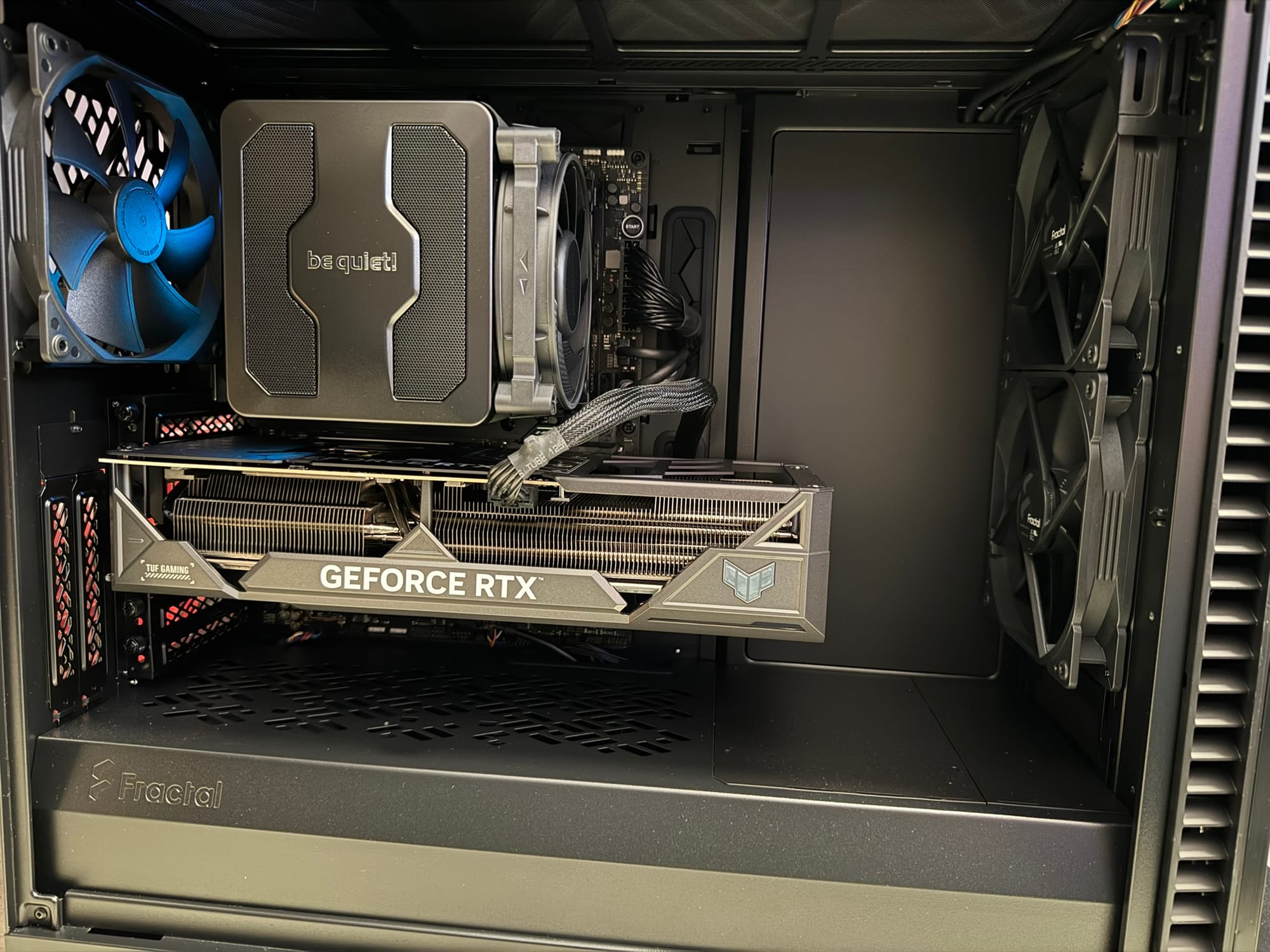
You can read about results in performance and noise at the end of this blog post.
Peripheral requirements
The existing setup needed to be extended to re-use the monitor and network connections.
One monitor, 2 PCs - KVM switch
A KVM switch basically allows you connect peripherals (mouse, keyboard, display) to 2 or more PCs, and you can seamlessly switch between the two. I've used this setup in my job at the University of Vienna with 2 PCs and 4 displays in 2010, one workstation, one monitoring host displaying Cacti graphs.
The Samsung Odyssey 49" monitor works best with 120Hz and 5120x1440 resolution, and Displayport connections instead of HDMI or USBC. The KVM switch and the NVIDIA GPU in the new gaming PC would need to support Displayport 1.4 as well. For NVIDIA GPUs, this is the default fortunately, the RTX 4080 SUPER comes with 3 Displayport and 2 HDMI connections.
For the KVM switch, I ended up trusting UGREEN with ~70EUR - works like a charm after 7 months. It fully supports USBA and USBC, and the extended switcher button as a long enough cable.
| Type | Description | Where to buy |
|---|---|---|
| KVM Switch | UGREEN 8K @ 60Hz Displayport KVM Switch, DP 1.4 KVM Switch, KVM Switch 2 PC 1 Monitor, 4K @ 240Hz, 4 Port USB Switch, KVM Switch USB C, 4 Port USB Switch | Amazon |
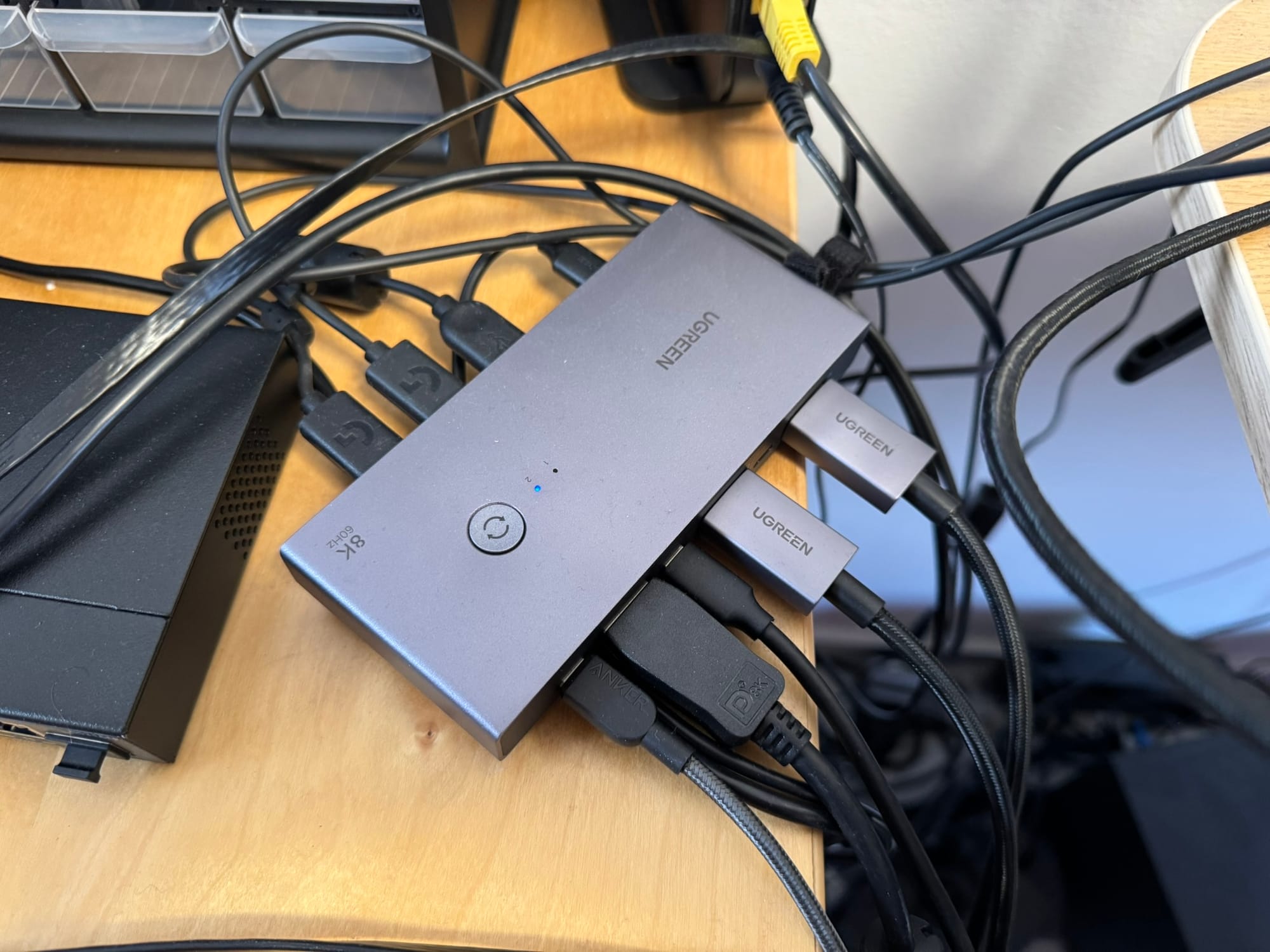
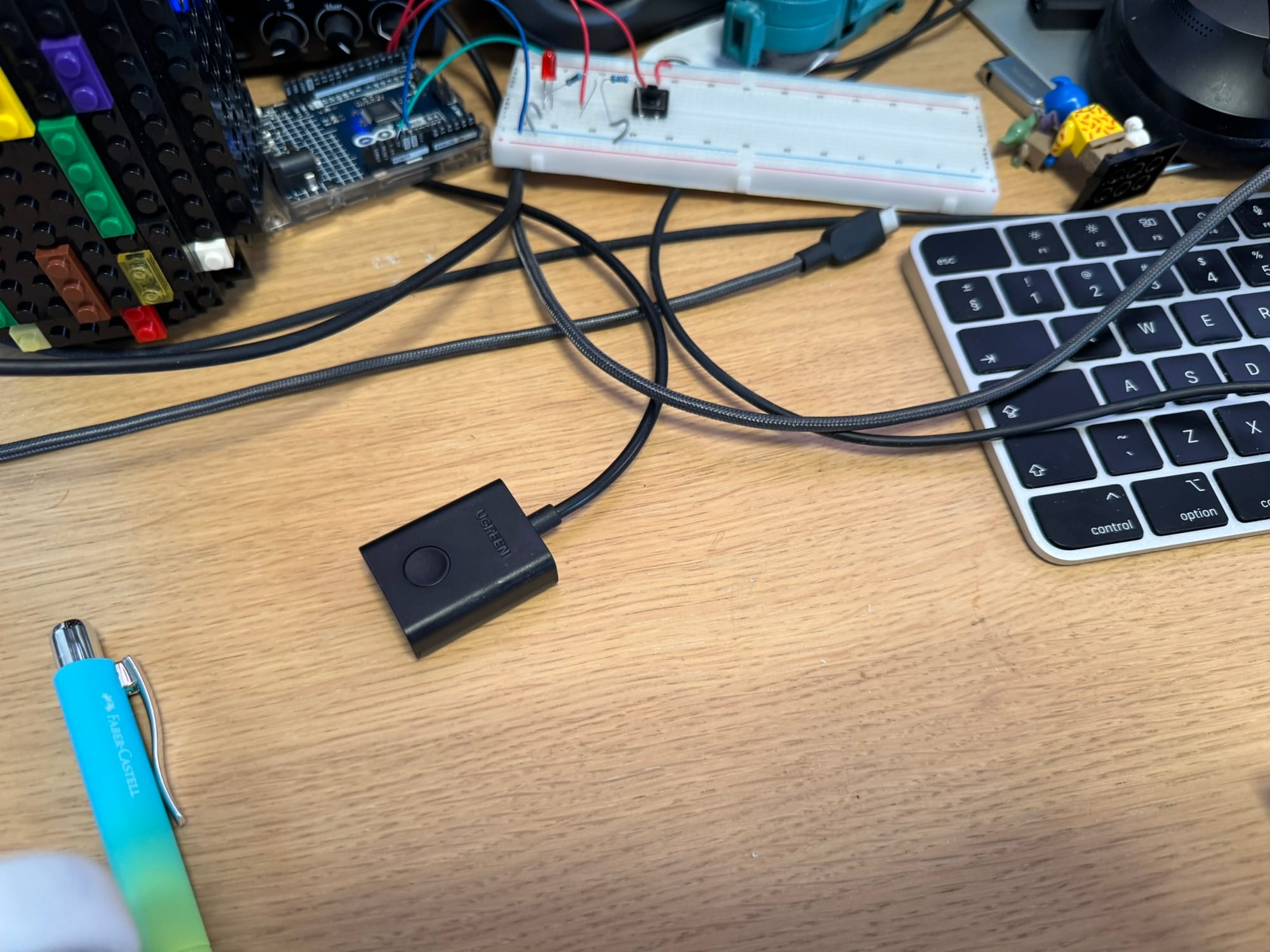
Network connections
I've upgraded the small NETGEAR 4 port switch from my Raspberry Pi research to a 16 port PoE switch to aid the expansion of my homelab. The Caldigit dockingstation (Macbook), Windows Gaming PC, 2x Raspberry Pi are currently connected, and 2 more NVIDIA dev kits are arriving hopefully soon. PoE is an requirement for any sort of IoT or embedded devices that can benefit from power over ethernet, and reduce power supply cable chaos.
The NETGEAR 300 Series Plus Switch (GS316EP): 16-Port PoE+ Gigabit Ethernet Plus Switch (180W) with 1 SFP Port was a bit pricy with its target of business offices, but offered managed 16 ports for specific network requirements (VLANs, QoS) and comes fan-less supporting my silent remote office.
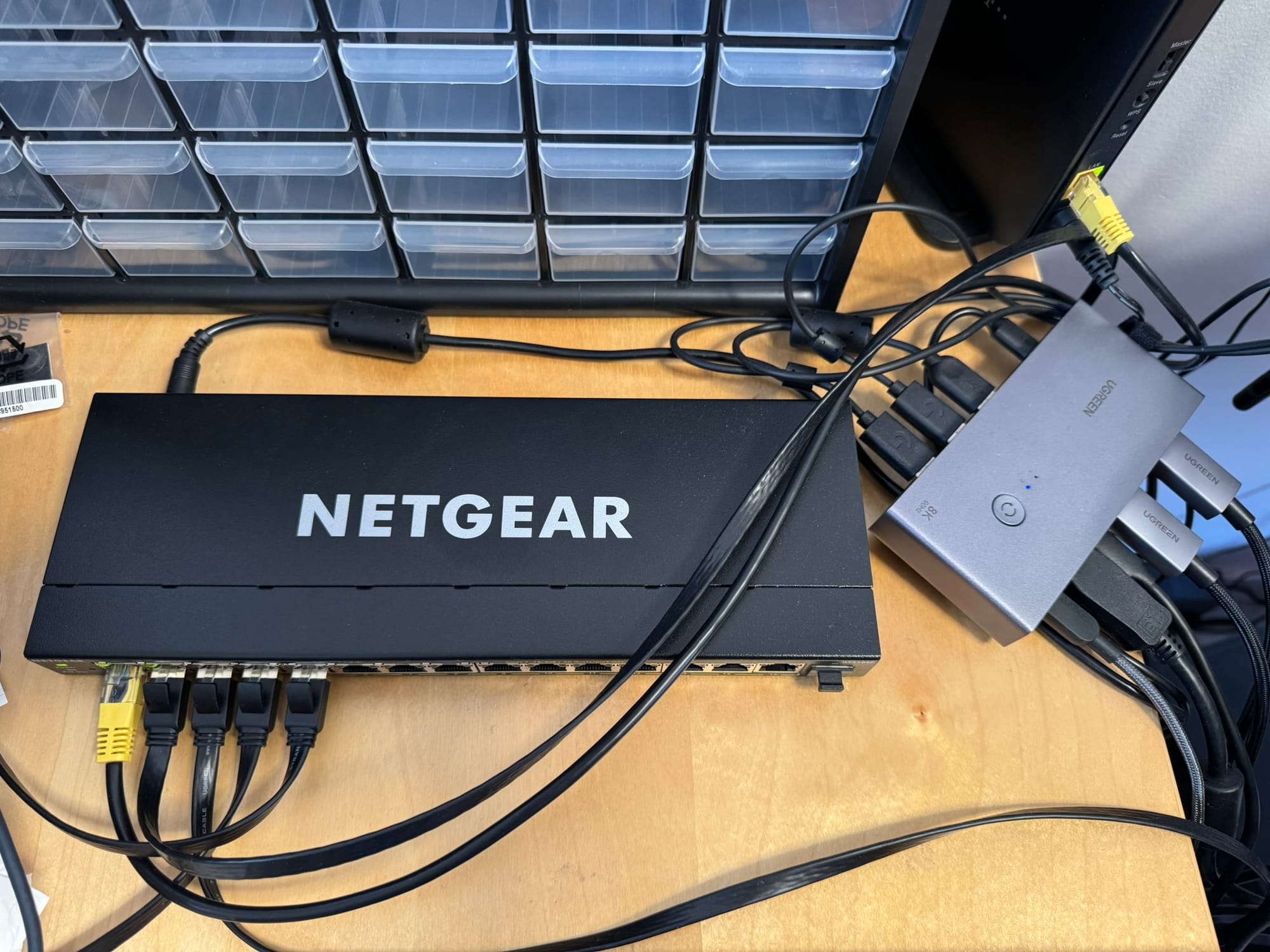
| Type | Description | Where to buy |
|---|---|---|
| Network switch | NETGEAR GS316EP Switch 16 Port Gigabit Ethernet LAN PoE Switch Plus | Amazon |
Keyboard and mouse
The Macbook works best with the Apple Magic Keyboard and Trackpad. This is my work environment, and must not be touched. Therefore, a new Windows Gaming keyboard and mouse were required. I always had good experiences with Logitech, except for the wireless mouse charging. Fortunately, the technology evolved and Logitech provides a wireless mouse on a gaming pad which automatically charges the mouse.
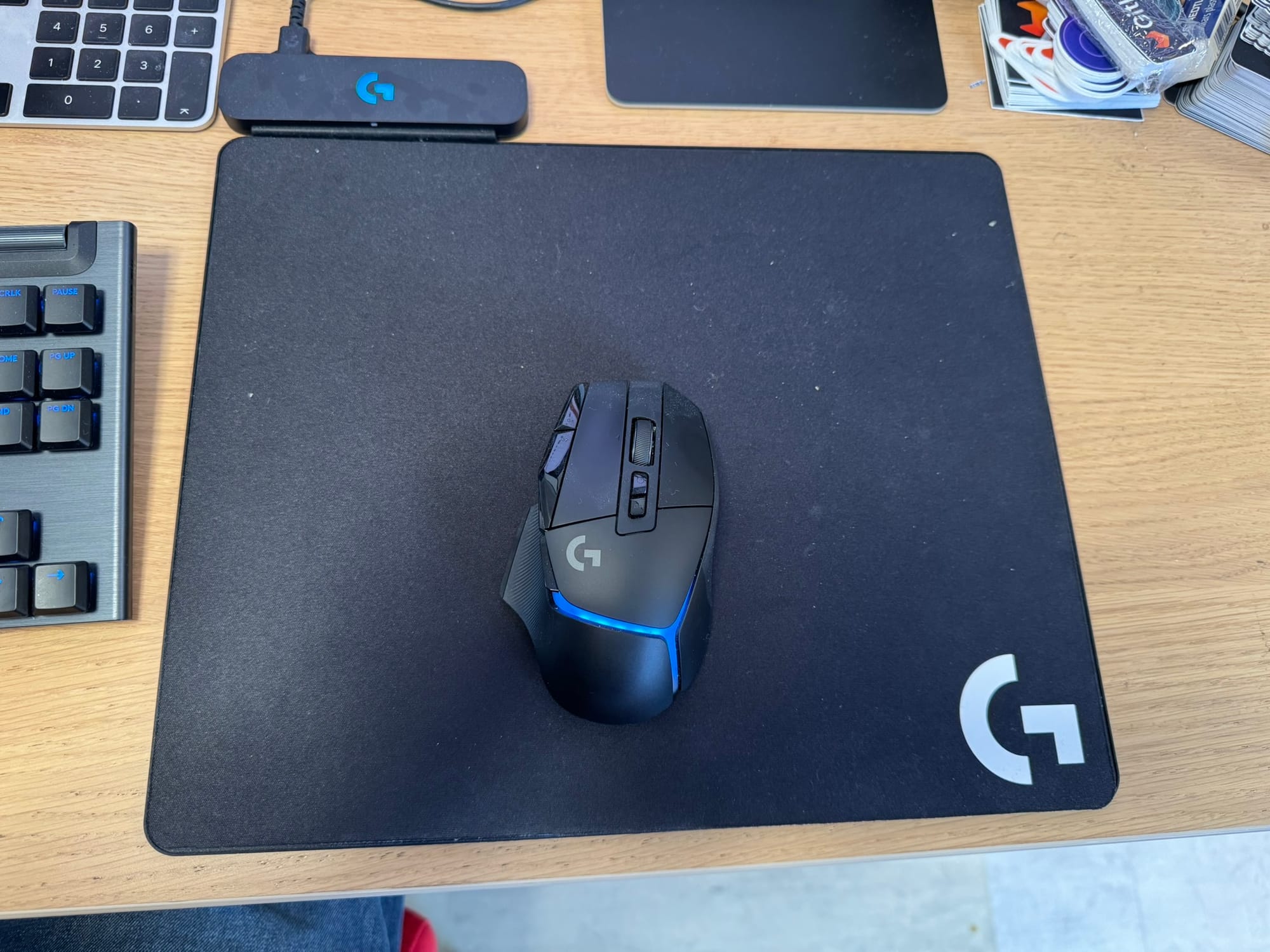
For the keyboard, I went with a smaller edition without the numbers block. The keystrokes feel natural (Tactile edition), albeit different to the Apple Magic keyboard. After I had switched to the English keyboard layout in 2023 (re-learning the layout after 20 years using de-AT/DE), the Logitech keyboard also needed the en-US layout.
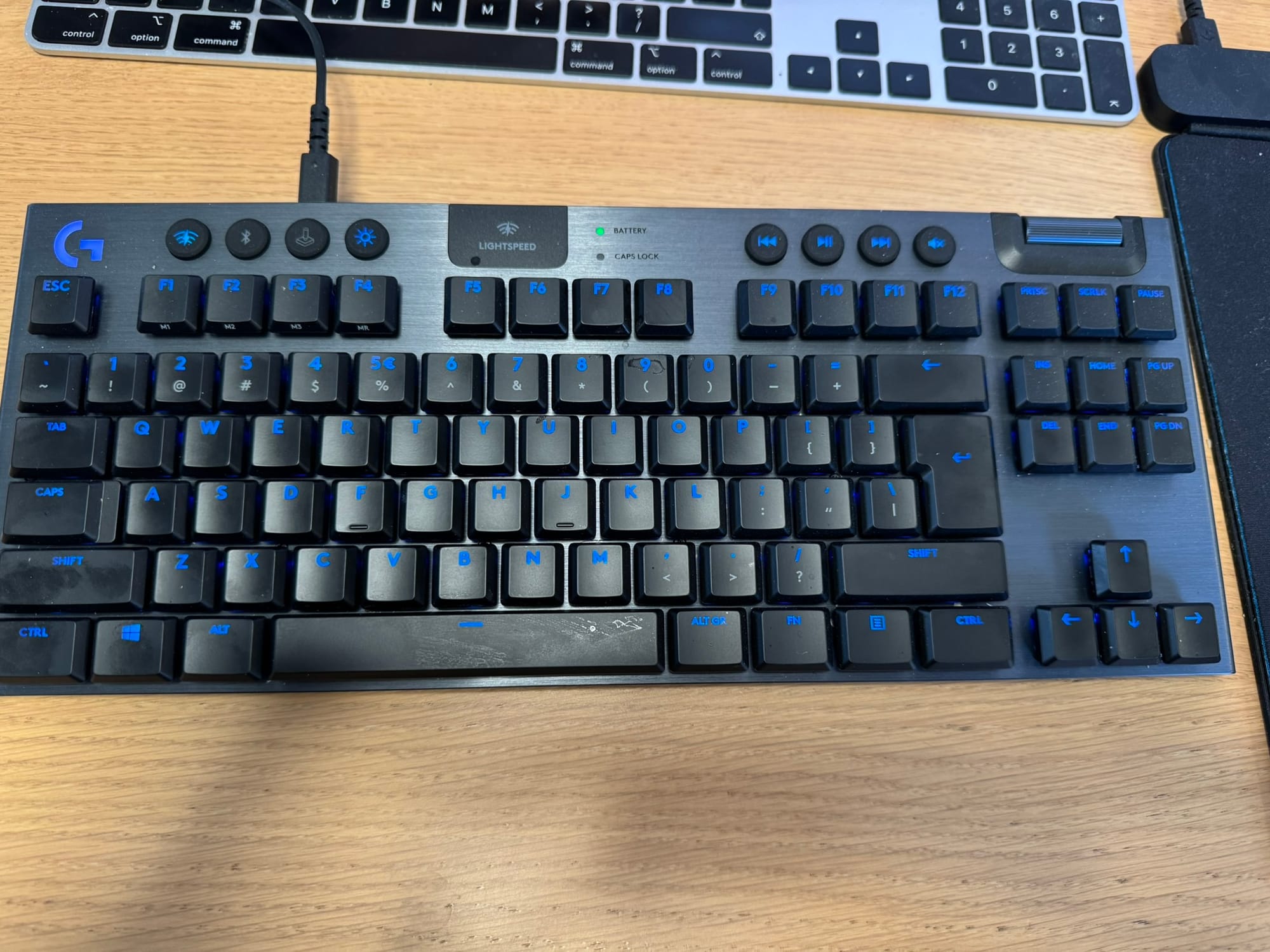
Tip: I ordered directly at Logitech because they had a special deal running, which saved me 50EUR on the mouse, and was cheaper in comparison to other platforms.
For cable management reasons, I connected the keyboard and mouse USB and remote connectors with the KVM switch sitting on the table. The PC under the table would have needed longer cables, and eventually I want to use the same keyboard for a private Macbook in the future as well.
| Type | Description | Where to buy |
|---|---|---|
| Keyboard | Logitech G - G915 X Lightspeed TKL (without numbers block, Carbon US-International, Tactile) | Logitech |
| Mouse | Logitech G - G502X Plus gaming mouse | Logitech |
| Charging pad | Logitech G Powerplay Wireless Charging System | Logitech |
Upgrades in 2024
After using the new PC for a while, I also started new projects for using it, as well as was not satisfied with the office arrangements.
Remote office desk upgrades
You don't see this in my Zoom calls - on the left of the standing desk, an old IKEA desk houses old PCs, monitors and also serves as embedded hardware connection spot. The printer on the table blocked that idea, and so I re-arranged the setup a bit.
The printer is now located on the right on an existing office shelve. This solves 2 problems:
- The Windows gaming PC fits into the previous shelve spot under the table, and is easily accessible for cable management.
- The area on the table is free for hardware components management, a network switch, the KVM switch, and the work Macbook. That way the main standing desk is just using the monitor area, and leaves space for refreshments and new keyboards/mouse.
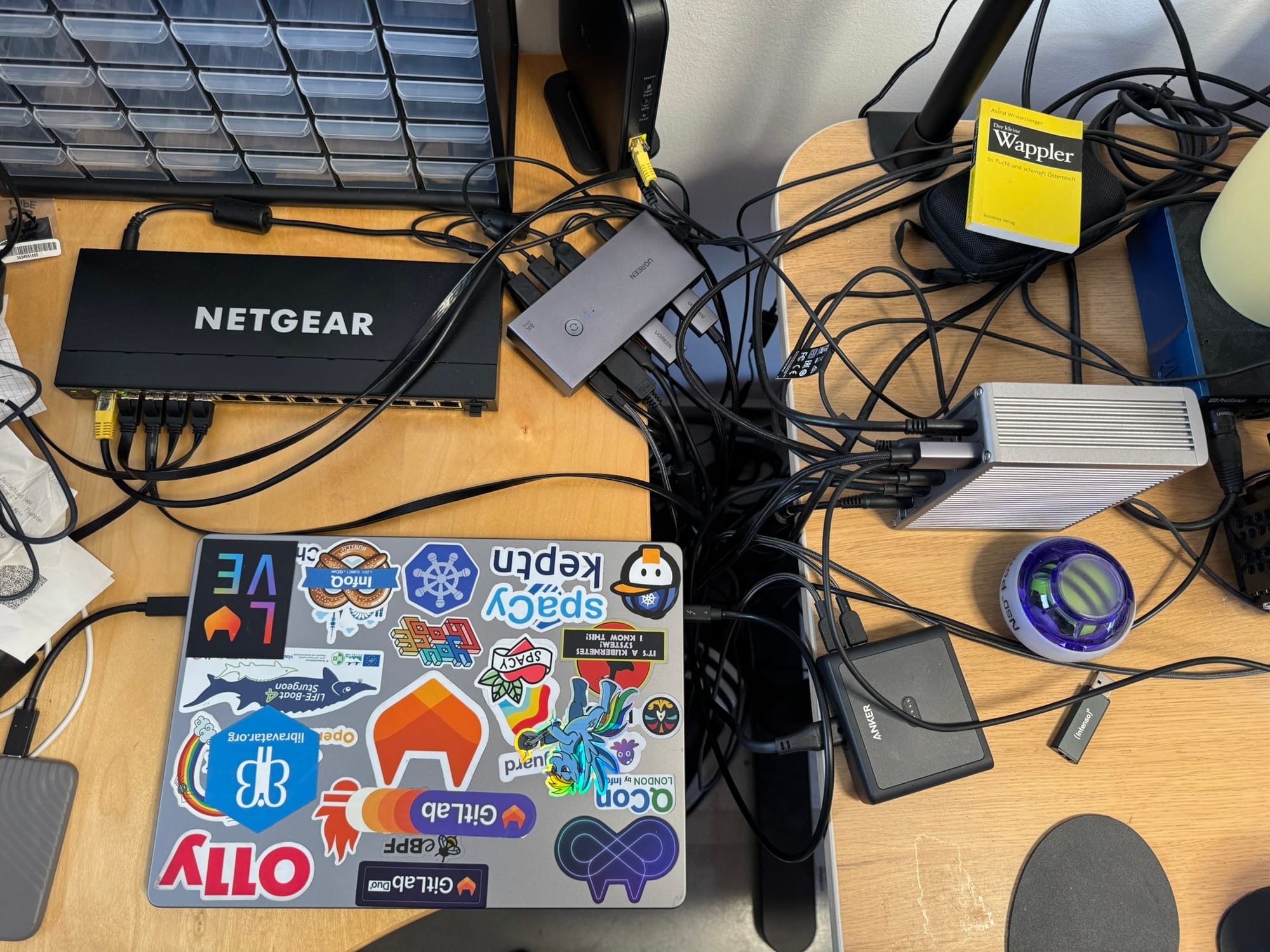
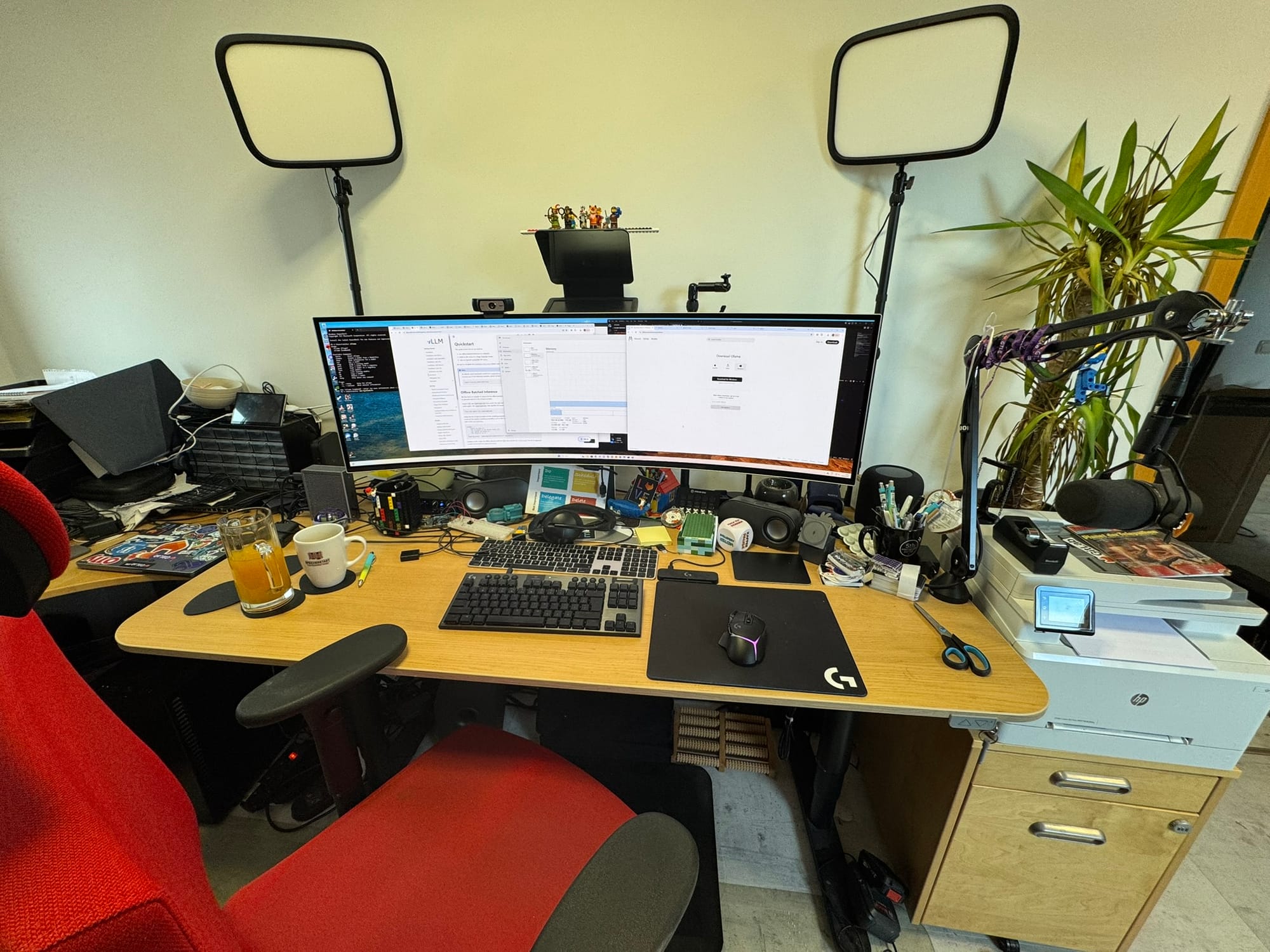
Hardware upgrades
In late 2024, the idea for self-hosted models came around, and I started experiments with Ollama and vLLM on Windows, using the NVIDIA GPU and the available 32 GB RAM. I quickly learned that some LLMs will require 32/64/128 GB RAM to function faster, next to fast GPUs.
This brought me into a new research on the existing RAM, and which upgrade options are officially supported.
The ASUS ROG STRIX Z790-F GAMING WIFI mainboard is very well documented and provides a searchable QVL (qualified vendor list) for RAM options. In my case, I selected the "14th Gen Intel Core" option from the dropdown and learned about
- Dual channel on 2 DIMMs is preferred. 4 DIMMs require lower frequencies to run stable.
- The ASUS - ROG STRIX Z790-F GAMING WIFI mainboard supports 192 GB RAM at maximum, which means 4x48 GB or below. I would have continued using Kingston if they had supported more than 128 GB (4x32GB).
- You should always upgrade using the same serial number and kit, and not mix different vendors and DDR frequencies. Always buy RAM kits from the official QVL and extract the kit vendor IDs for buying them from your preferred vendor.
- RAM vendors support so-called CPU optimized profiles for Intel XMP 3.0 (Extreme memory profile) and AMD EXPO (Extended Profiles for Overclocking)
- DDR5-5200 compared to DDR5-6000 will drop a bit of gaming performance in the range of 10% with overclocked memory profiles according to benchmarks. This is a price I am willing to pay for large RAM and LLMs.
- Upgrading BIOS firmware for newer RAM support still requires USB drives with FAT32. ASUS upgraded the BIOS screen to 1080p.
I was fighting with myself whether to go with 96GB, 128 GB or 192 GB RAM. After considering the fact that immediate future upgrades could mean that I would need to replace all 4 DIMMs again, I decided to go for the expensive investment of the maximum 192 GB. This allows to run LLMs (llama3.3 70B consumes ~50GB with Ollama) and additional VMs (Ubuntu playground with agents, servers and runners).
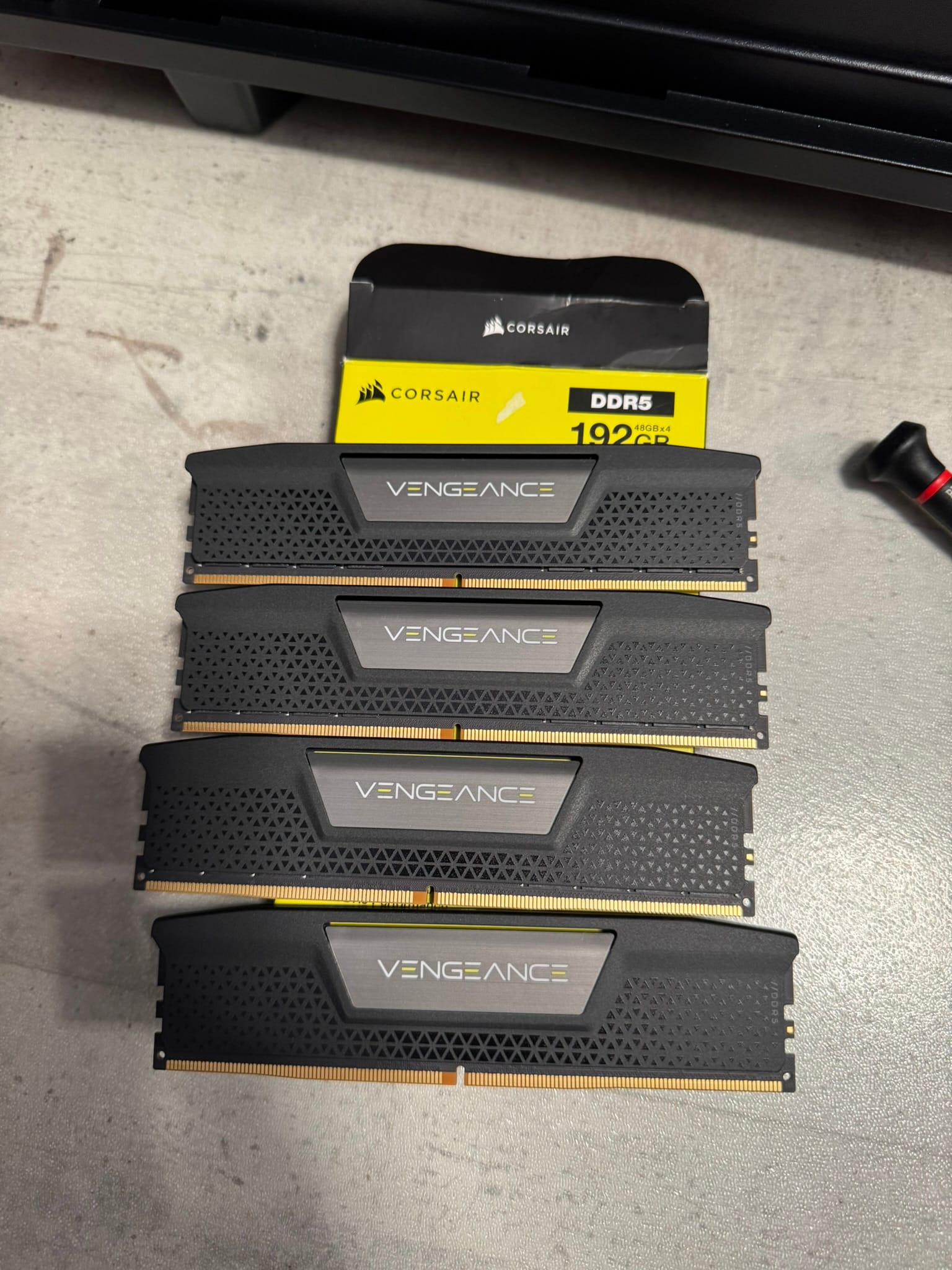
The upgrade itself was very-straight forward: Unplug the power and peripheral cables on the right side of the mainboard to access the RAM DIMMs. Remove the sponge holding the be quiet CPU cooler to freely remove/add each DIMM. Once assembled, plug the cooler and connectors again. Boot the system and check the mainboard LEDs for any error messages.

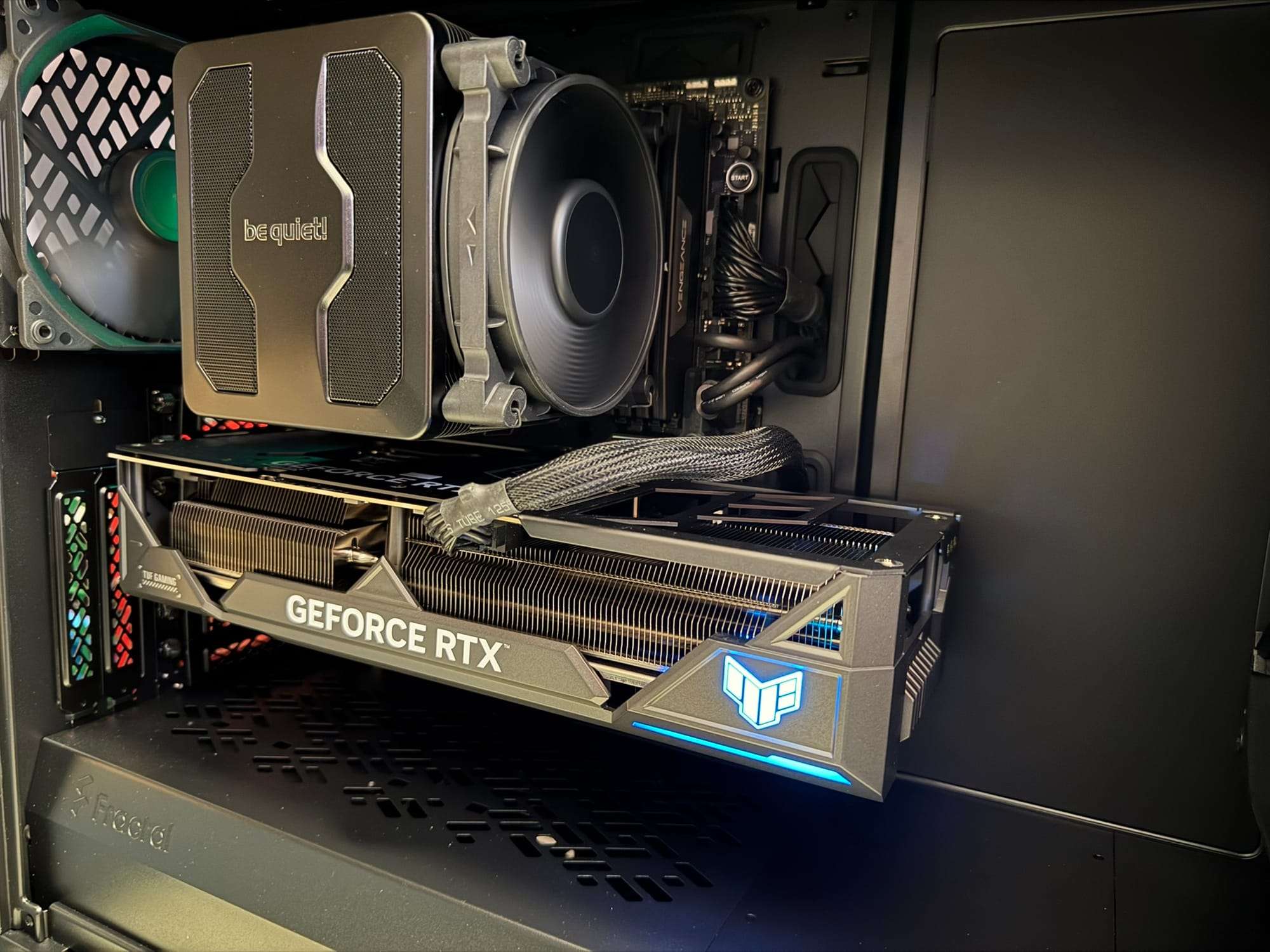
Windows 11 Home supports up to 128GB, which required me to upgrade to Windows 11 Pro. I had planned with it anyways, supporting more virtualization options with Hyper-V. The upgrade was straight-forward through the system settings in System > Activation .
I'll share self-hosted LLM setups, experiments and benchmarks in a future blog post :)
Impressions
The KVM switch extender on the table is just one button click to switch sources. The two different keyboard/mouse options are not optimal, but given their lightweight and small sizes, it is an easy switch when necessary. During work hours, I only use my Macbook anyways. I now type as fast on the Logitech keyboard as on the Apple Magic keyboard. Only the Windows keyboard shortcuts are a little distracting when you are used to macOS for a long time :)
Performance and noise
The PC is really silent. The be quiet! CPU cooler, the ASUS Geforce coolers, and overall case coolers do their magic, together with pre-defined mainboard PWM profiles. Left everything at default.
Performance is fast with no lags on an ultrawide display. It can also run Docker containers, and LLMs.
First immersive experience: Red Dead Redemption 2
Playing in 5120x1440 feels different but after a while, you are just into the world. I can understand why gamers love the experience. RDR2 was released on PC in 2018, more than 6 years ago and still nailed it.
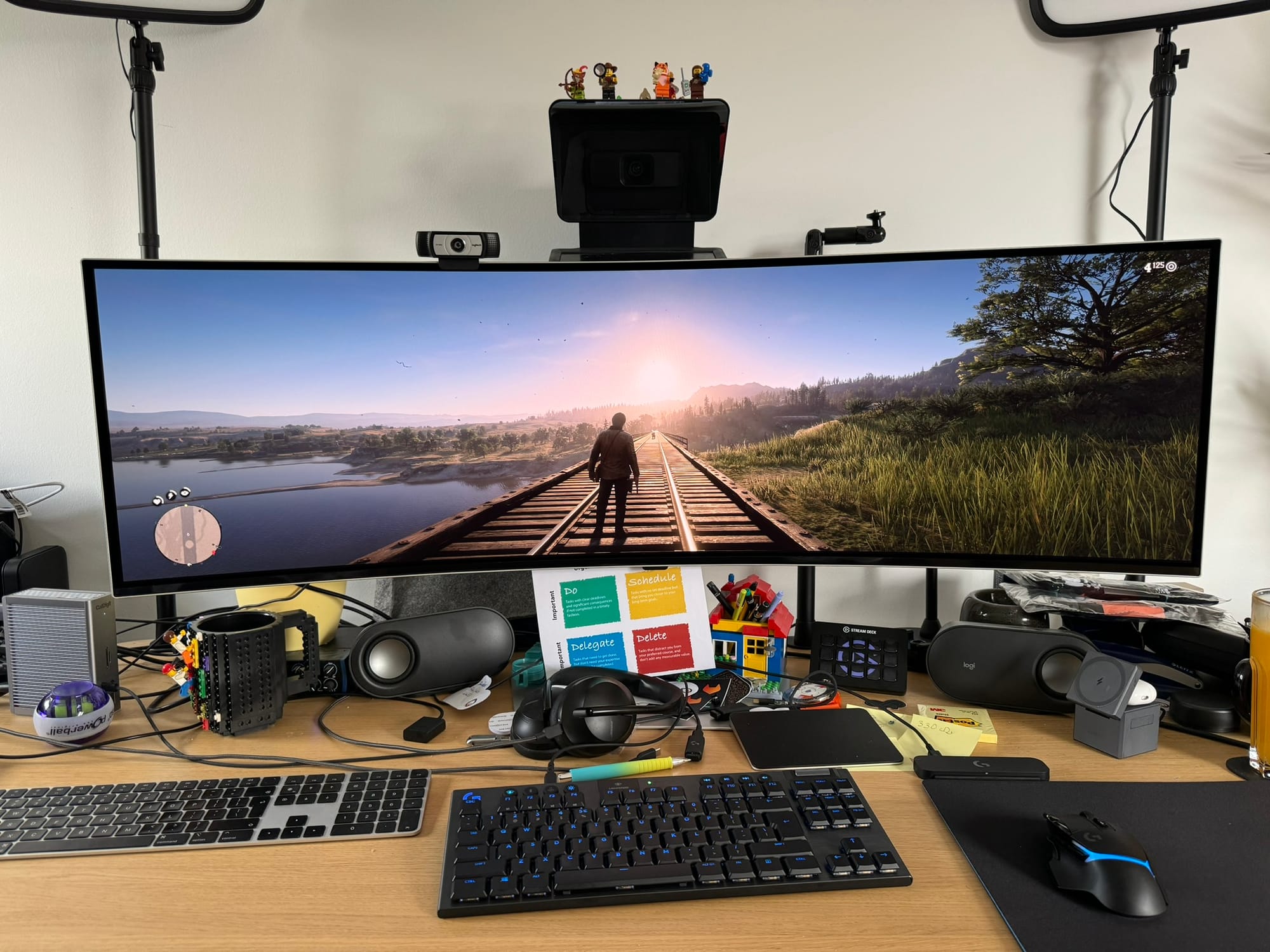
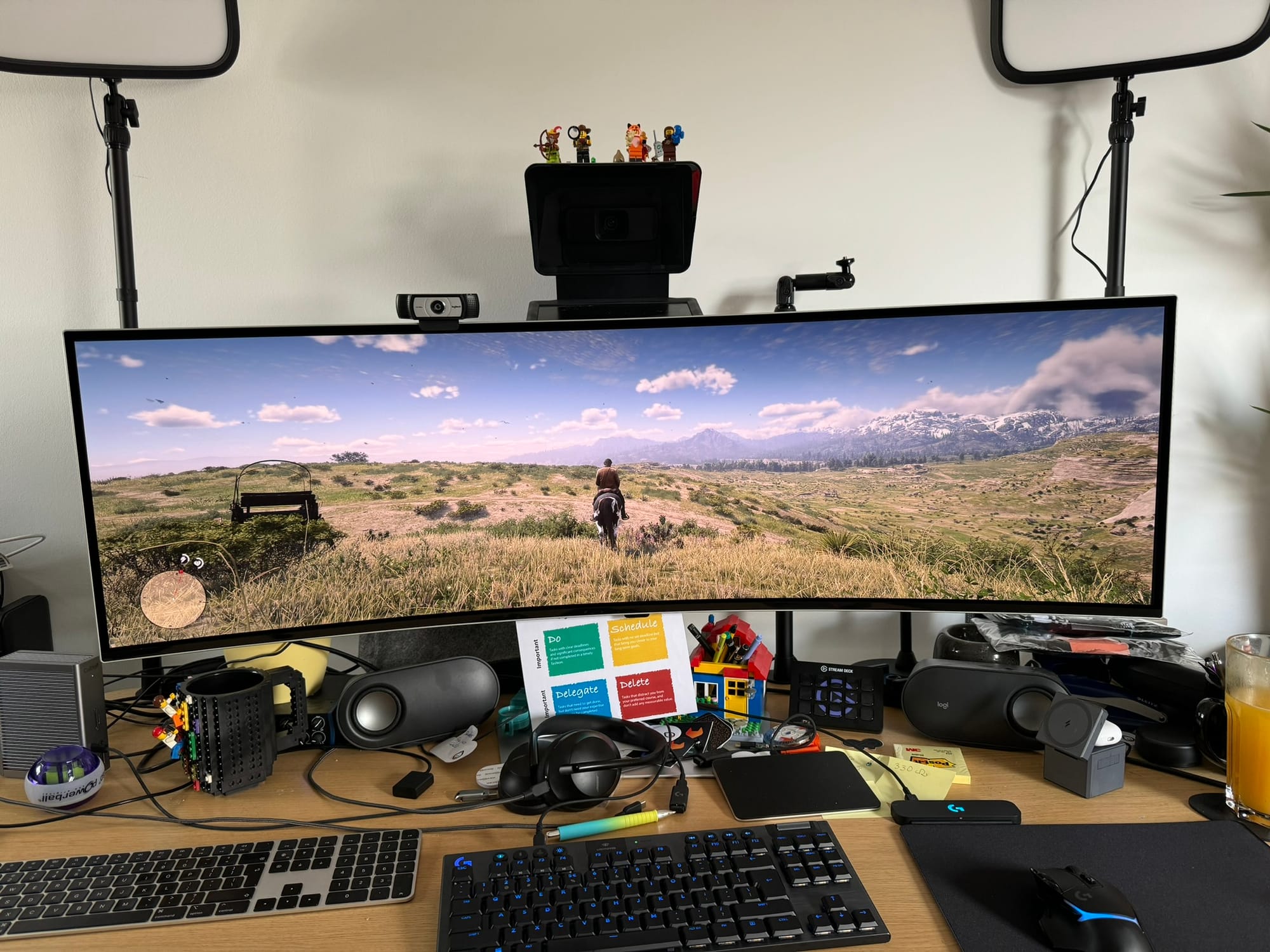
What's next
In 2025, I want to explore following topics:
- Find more games that are relaxing and immersive. Hard to beat Red Dead Redemption 2 though.
- Self-hosted LLMs, AI-powered development use cases, embedded development exploration on Windows
- Install a Dual-boot Ubuntu and run Kubernetes and self-managed GitLab (or just let it run on Windows in VMs with now 192 GB RAM)
Appendix
PC components
| Type | Description | Notes |
|---|---|---|
| CPU | Intel(R) Core(TM) i7-14700K, 3400 Mhz, 20 Core(s), 28 Logical Processor(s) | Intel.com, Part of assembled PC |
| Motherboard | ASUS ROG STRIX Z790-F GAMING WIFI | Asus.com, Part of assembled PC |
| RAM - original | 32 GB DDR5-6000 Kingston Fury Beast, 2x16GB Kit | Kingston.com, Part of assembled PC |
| RAM - upgrade | 192 GB DDR5-5200 Corsair Vengeance, 4x48GB Quadkit | Bought on Alternate |
| Disk | 2TB Samsung SSD 990 PRO | Samsung.com, Part of assembled PC |
| GPU | ASUS GeForce RTX 4080 SUPER TUF Gaming OC, 16GB GDDR6X (Display: 5120x1440x120 hertz) | Asus.com, Part of assembled PC |
| Case | Fractal Design Define 7 Black Build | fractal-design.com, Part of assembled PC |
| CPU cooler | be quiet! Dark Rock 5 | bequiet.com, Part of assembled PC |
| Power supply | be quiet! Pure Power 12M 850W | bequiet.com, Part of assembled PC |
Peripherals
| Type | Description | Where to buy |
|---|---|---|
| Keyboard | Logitech G - G915 X Lightspeed TKL (without numbers block, Carbon US-International, Tactile) | Logitech |
| Mouse | Logitech G - G502X Plus gaming mouse | Logitech |
| Charging pad | Logitech G Powerplay Wireless Charging System | Logitech |
| KVM Switch | UGREEN 8K @ 60Hz Displayport KVM Switch, DP 1.4 KVM Switch, KVM Switch 2 PC 1 Monitor, 4K @ 240Hz, 4 Port USB Switch, KVM Switch USB C, 4 Port USB Switch | Amazon |
| Network switch | NETGEAR GS316EP Switch 16 Port Gigabit Ethernet LAN PoE Switch Plus | Amazon |
